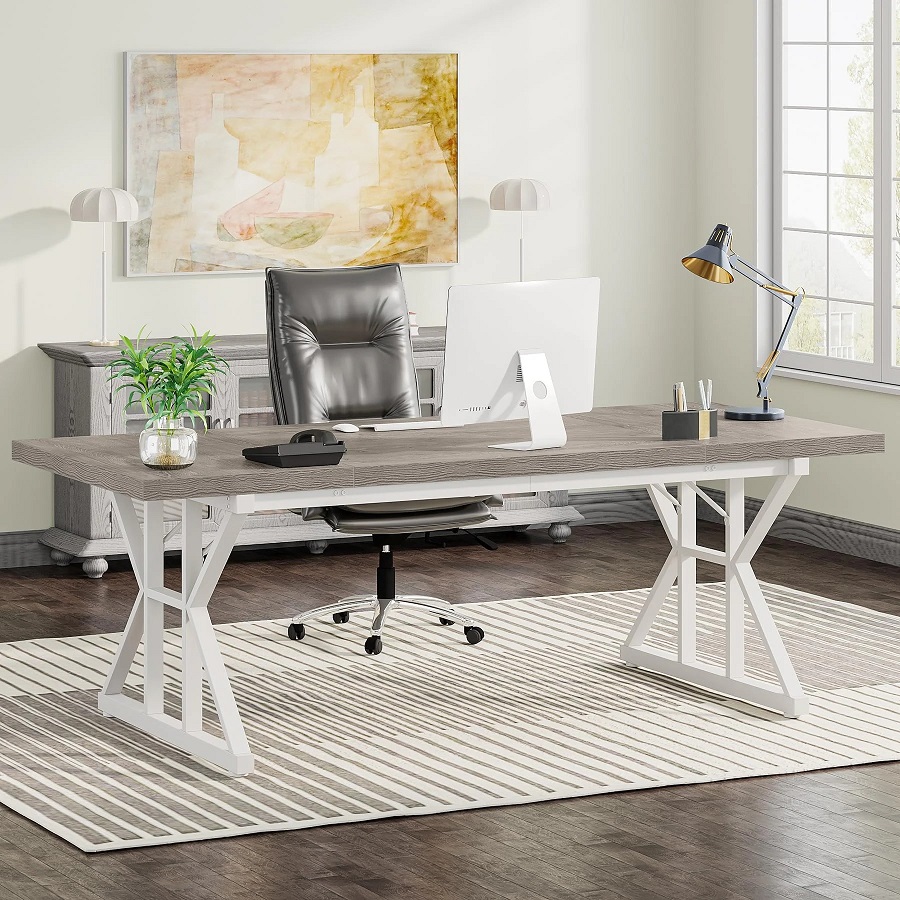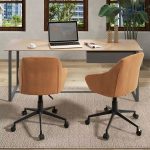Evolution of Office Desks Over The Years
Office desks have come a long way through history. From the rigid, bulky structures of the past, we now see sleek, adaptable forms taking over. Decades ago, office desks were purely functional. They offered a stable surface with minimal storage. As the working world evolved, so did the need for more personalized and efficient workstations.
In the 20th century, metal desks with typewriter compartments became a staple. However, they gave way to the cubicle era of the 1980s and 1990s. This period saw the rise of the workstation, aiming to maximize space efficiency. Yet, these often lacked in comfort and aesthetic appeal.
As the digital age dawned, the need for desktop computer accommodation transformed desk designs once again. The bulky CRT monitors of the time dictated the desk space and layout, leading to larger, more compartmentalized desks.
Entering the 21st century, contemporary office desk designs began to prioritize flexibility and minimalism. Breakthroughs like flat-screen monitors and laptops allowed desks to become more compact and streamlined. The focus has now shifted to creating spaces that promote well-being, collaboration, and adaptability. Modern desks incorporate ergonomic features and accommodate the latest technology.
With each passing year, designers push the limits, blending form and function. Current trends lean towards desks that are not only practical but also contribute to the aesthetic of a workspace. Hence, contemporary office desks are not just a piece of furniture; they’re a statement on modern work culture.
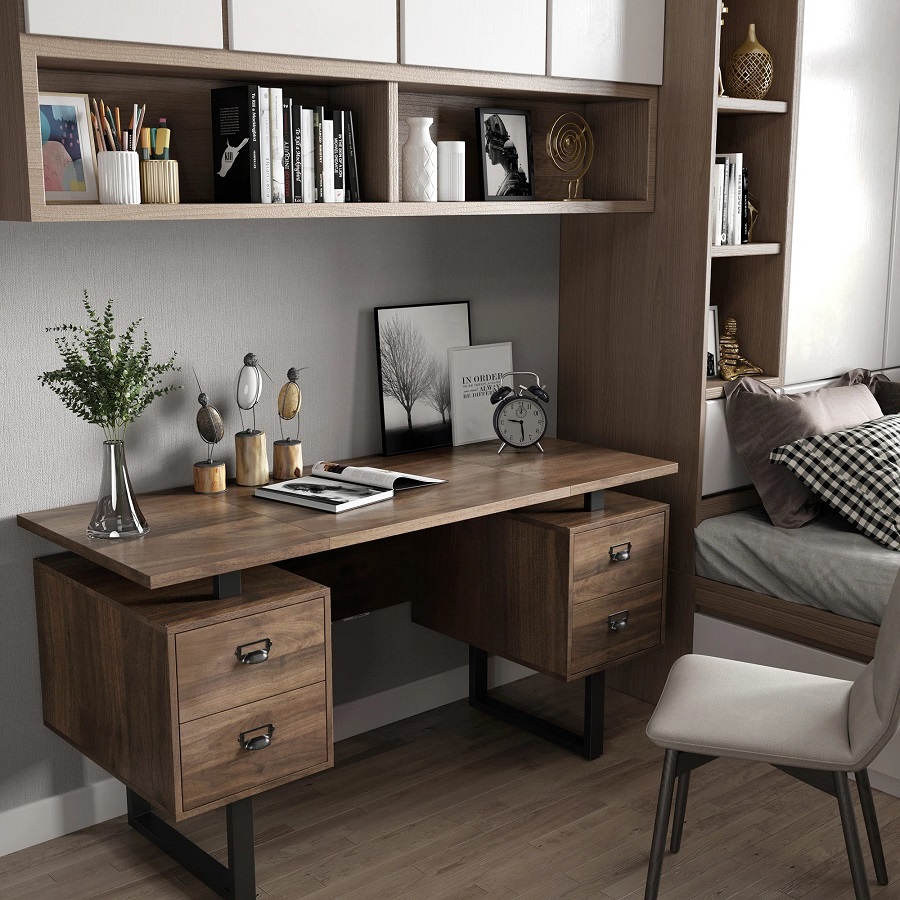
Key Features of Contemporary Office Desks
Modern office desks go beyond sleek looks. They pack key features that match the pace of innovation in workplace design. Here, we’ll explore two significant characteristics. Keep an eye out as they might be just what you need for that perfect contemporary office desk.
Ergonomic Designs for Enhanced Comfort
Ergonomic features are at the core of contemporary office desk designs. The emphasis is on avoiding strain and fatigue. Desks now boast adjustable heights, allowing users to alternate between sitting and standing. Curved edges and contoured tabletops prevent discomfort from extended working hours.
Armrests and monitor stands have also become common. They help position your body in a way that reduces pressure on your wrists and eyes. When you’re comfortable, you’re more productive. That’s an invaluable trait in any workspace.
Integrated Technology Solutions
Technology is inseparable from the modern workspace. Contemporary office desks reflect this by incorporating integrated tech solutions. This means fewer wires, built-in charging ports, and seamless connectivity.
Remember those clunky PC towers? They’re no longer an eyesore. Desks now have discreet CPU holders and cable management systems. This keeps your workspace tidy and your mind clear. And with the right desk, syncing up all your devices is a breeze. This kind of tech integration is no longer a luxury. It’s a necessity for the contemporary professional.
Popular Materials in Modern Office Desk Construction
The materials used in constructing contemporary office desks shape their function, form, and footprint on the environment. Nowadays, materials are not just chosen for durability and aesthetics; sustainability plays a pivotal role. Modern desks blend industrial materials with natural elements. This mix caters to the demand for sturdy yet stylish office furniture. Innovations like composite materials have also risen, offering lightweight and long-lasting surfaces.
Sustainable and Eco-Friendly Options
Sustainable materials are witnessing a surge in popularity in office desk construction. They help to reduce the environmental impact of furniture production. Some eco-friendly materials include:
- Bamboo: This fast-growing plant is not just strong; it’s a sustainable alternative to wood.
- Recycled metals: Recycled aluminum and steel use less energy in production and lessen waste.
- Reclaimed wood: Utilizing previously used wood gives desks a unique look and conserves forest resources.
Designers are also embracing non-toxic finishes and adhesives. These reduce harmful emissions, contributing to a healthier workspace. As we aim for greener offices, choosing furniture made with such materials is key. We’re not just picking a desk for today; we’re investing in the future of our planet.
The Rise of Smart Desks in Workspace Design
Smart desks have become central to modern workspace design, reflecting the rapid integration of technology into our daily work lives. These desks are more than just surfaces to hold your computer and paperwork; they are interactive, intelligent, and adaptable to the complexity of tasks that define contemporary work. Smart desks often feature built-in touch screens, voice control options, and even AI-powered tools that can help schedule your day, manage tasks, or remind you of important deadlines.
One remarkable aspect of smart desks is their ability to automate functions. For instance, they can adjust height with a single command, making the switch from sitting to standing workspaces effortless. Furthermore, some of these desks can track your time spent sitting and prompt you to stand, benefiting your posture and overall health.
Customization has taken the front seat as well. Users can control desk settings through an app, customizing the desk’s behavior to fit personal preferences. Smart desks can also save these settings, ensuring a personalized experience every time you start your workday.
Connectivity is another big leap for smart desks. These desks seamlessly sync with other devices in the office, providing a centralized control system for everything from your computer to your smartphone and even to your smart office accessories.
Incorporating smart desks into workspace design signals a move towards an ecosystem where convenience, health, and productivity merge. As contemporary office desks evolve, smart technology redefines what we can expect from the places we work in, setting a new standard in office furniture.
Flexible Workspace Solutions: Modular and Adjustable Desks
Today’s workspaces need to adapt quickly and efficiently. Modular and adjustable desks are leading the trend in flexible workspace solutions. These contemporary office desks cater to changing needs, from collaborations to quiet individual work. Here’s why they’re on the rise in 2025 workspaces.
Tailored to Space Requirements
Modular desks come in parts that fit together in various configurations. You can expand or contract layouts to fit the space. They are simple to reorganize, making them ideal for offices that evolve or change frequently.
Supports Teamwork and Individual Work
Team projects require large, communal spaces. However, tasks that need focus benefit from a smaller setup. Adjustable desks offer the flexibility to cater to both types of work. You can easily switch between spacious or compact desk arrangements.
Health and Well-being Focus
Standing desks are part of this category, promoting movement and reducing sitting time. They are easy to adjust, making transitions from sitting to standing smooth and helping maintain physical health.
Customization for Personal Comfort
These desks allow users to control the height and layout to match personal comfort preferences. With this, each user can create an ergonomic setup that decreases strain and boosts productivity.
Modular and adjustable desks are revolutionizing office spaces. They bring together functionality, health, and adaptability, proving indispensable for contemporary work environments.
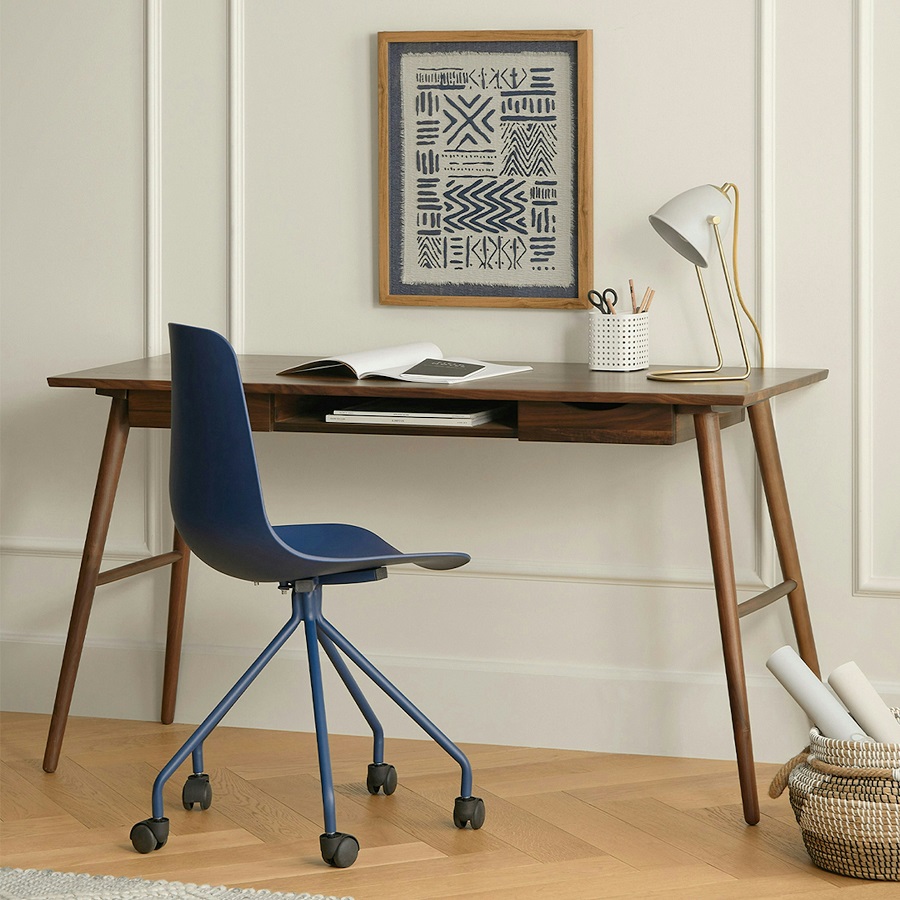
Aesthetic Trends: Color Palettes and Shapes in 2025
As we delve into 2025, the aesthetic trends in contemporary office desk designs are dynamic and vibrant. Bold color palettes and organic shapes set the tone for creating a pleasant and stimulating work environment. Here’s a look at what’s defining the style of office furniture this year.
Embracing Vibrant Colors
Gone are the days of dull, monochromatic office desks. In 2025, we see a burst of color in the workplace. Desks now come in a range of hues from energizing brights to calming pastels. These colors add a pop of personality and can influence mood and creativity.
Using color strategically can also delineate different areas within an office. For example, a bright red contemporary office desk might signal a space for dynamic brainstorming, while a soft green could denote a calming corner for focused work.
Geometric and Organic Shapes
This year, we are seeing a shift away from the sharp, angular lines that have long characterized office furniture. Instead, contemporary office desks are featuring smooth, rounded edges and organic forms.
These shapes not only contribute to a modern aesthetic but also enhance comfort and safety. The absence of sharp corners means less chance for bumps and bruises in tight office spaces. Moreover, these flowing designs can make small workspaces feel larger and more open.
Biophilic Design Elements
Nature-inspired motifs are making their mark in office desk designs. Patterns that mimic natural textures like wood grain or marble add a touch of the outdoors inside. It’s all part of the biophilic design trend that aims to connect people with nature, even while indoors. Desks that incorporate these elements contribute to a sense of wellbeing and relaxation, which is vital for productivity.
Overall, the aesthetic trends for contemporary office desks in 2025 are about creating a workspace that inspires and invigorates. From color choices that lift spirits to shapes that flow with the natural human movement, the future of office furniture looks bright and promising.
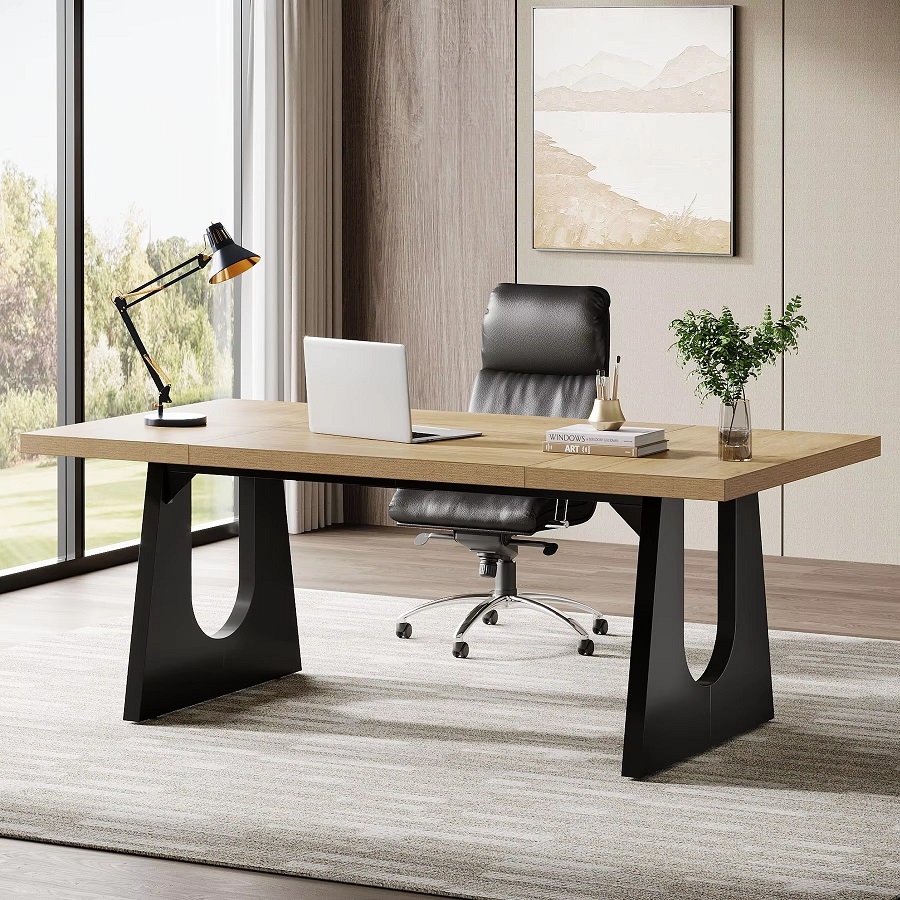
The Role of Office Desks in Collaborative Work Environments
In 2025, work practices emphasize teamwork and idea sharing. Contemporary office desks play a vital role in fostering collaboration. Here’s how they are reshaping collaborative work environments.
Facilitating Communication
Open desk layouts encourage conversation and the exchange of ideas. Desks grouped in pods or clusters make it easy for teams to discuss projects. They face each other, which helps in reading non-verbal cues. This setup breaks down barriers and promotes a free flow of information.
Versatile Work Stations
Desks today must serve various purposes. One moment, they can be a meeting spot for a team. The next, they transform into a quiet space for focused work. Contemporary office desks are not just surfaces; they are dynamic hubs for various work modes.
Tech Integration for Seamless Collaboration
Modern desks come with tech-friendly features. These include built-in power outlets and data ports. Teams can connect easily and share screens without leaving their seats. This tech integration is key for smooth, uninterrupted teamwork.
Promoting Equality
The design of the office desk can shape the workplace hierarchy. Today’s desks often have a uniform look and feel. They place everyone, from interns to managers, on the same level. This can encourage a culture of inclusivity and equality.
Adaptable to Changing Team Sizes
Flexible workstations are a must in a collaborative setting. They allow spaces to grow or shrink based on team size. It’s all about adapting quickly without disrupting the work flow.
Contemporary office desk designs consider the needs of a team. They create a space that encourages communication, supports technology, and adapts to the team’s size. A well-designed desk is an essential tool for successful collaboration in any modern workspace.
Selecting the Perfect Contemporary Office Desk for Your Space
Choosing the right contemporary office desk is crucial for productivity and comfort. The market offers various styles, features, and materials, making the selection process seem overwhelming. However, by taking into account certain factors, you can find the perfect desk for your workspace. Let’s break down what to consider before making your purchase.
Factors to Consider Before Making a Purchase
- Space: Measure your office space to determine the desk size that will fit comfortably. Keep in mind the desk’s shape and how it will align with other furniture.
- Ergonomics: Look for desks with adjustable heights and supportive features. These are key for maintaining good posture and preventing strain over long working hours.
- Technology Needs: Your desk should have room for all your gadgets. Built-in charging ports and cable management are important for a clean setup.
- Material Quality: Choose materials that are durable and match your office’s aesthetic. Consider eco-friendly options to support sustainability.
- Design Style: Pick a desk that reflects your personal style and complements the office decor. Color and shape play a big role in how the desk will feel in your space.
- Functionality: Think about storage needs and workspace requirements. Desks with drawers or modular features offer more flexibility.
- Budget: Set a budget beforehand. Remember, investing in a quality desk can improve productivity and well-being. It’s worth spending a bit more for the right fit.
- Future Growth: Consider whether your business might expand. A modular or flexible desk design can adapt to changing team sizes and functions.
By focusing on these aspects, you can narrow down your options and select a contemporary office desk that suits your workspace needs. Remember to weigh each factor against your daily work habits for the best outcome. The right desk is not just a purchase, it’s an investment in your work life.
